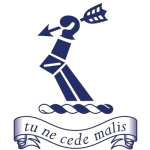
Martin Firth’s Guide to Kwik Cricket
Kwik Cricket? What’s that then?
Kwik Cricket is a simplified – and fast – version of cricket for children. It is played with plastic bats, stumps and balls, and therefore has no need for the protective equipment – pads, gloves, helmets and so on – beloved of hardball cricketers. The pitch is much smaller than a hardball pitch: the wickets are 16 yards apart (often closer for Under-9s), the boundary is about 30 yards from the wickets (although more often limited by the actual space available). Which means we can actually fit four pitches into Grange Loan, as opposed to the mere one for hardball games.
Basically, the game is so simple that an eight-year-old can understand it. Quite possibly only eight-year-olds.
A Kwik Cricket match comprises 16 overs. Teams have eight players, each team bats for an 8-over innings, and bowls/fields for an innings. All being well, a Kwik cricket game lasts about 45 minutes. That might well be enough information.
Er, OK, “bats” – what’s that about?
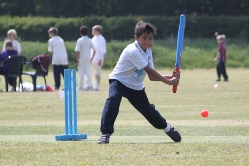 Players bat in pairs for two overs. They score runs by hitting the ball and running from one wicket to the other. If the ball crosses the boundary without touching the ground, they score 6 runs; if it crosses the boundary having touched the ground, they score 4 runs.
Players bat in pairs for two overs. They score runs by hitting the ball and running from one wicket to the other. If the ball crosses the boundary without touching the ground, they score 6 runs; if it crosses the boundary having touched the ground, they score 4 runs.
If a batsman is out, s/he carries on batting, but 5 runs are taken away from the team’s score. Because of the potential for negative runs, each team starts with 200 runs to avoid the awful possibility of negative arithmetic.
Players change ends when a 4 or 6 is scored; when one of them is out; at the end of an over; or (at the umpire’s discretion) after one player has faced 3 balls without scoring any runs.
That seems, er, straightforward. What about “bowls”?
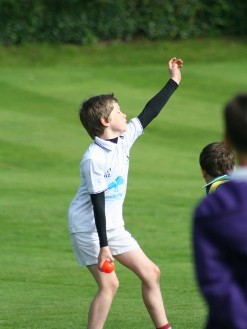 Each player bowls 1 over (6 balls).
Each player bowls 1 over (6 balls).
– A “wide” is called if the ball is too far from the batsman – say a yard or so. Two runs are added to the batting team’s score, plus any additional runs they score by hitting the ball and running in the normal way.
– A “no-ball” is called if the ball bounces more than twice before reaching the batsman, or reaches the batsman above about chest height.
Two runs are added – plus any additional ones actually run.
In most tournaments, wides and no-balls are bowled again in the final over of an innings, but not in the earlier overs. For this reason, it is a good idea for a competent bowler to bowl the last over.
Other variants sometimes played include:
– All wides and no-balls are re-bowled. We don’t often do this, as by the end of an Under-9 game, most players would have become Under-10s.
– Following a wide or no-ball, the batsman gets a free hit, either from a tee or from a ball bowled by the umpire. We sometimes do this, although it does make a game take up to an hour.
Hmm, you’ve used another word: “out”
The fielding side try to get a batsman out, also known as taking his/her wicket. A batsman can be out in several ways.
– Bowled – the ball from the bowler hits the wicket.
– Caught – the batsman hits the ball, and a fielder catches it before it hits the ground.
– Run out – the batsman run between the wickets, but the fielders hit one of the wickets with the ball before the batsman reaches it.
– Stumped – similar to run-out, but the fielder hits the wicket without the batsman trying to run. Unusual in Kwik Cricket, and usually the umpire will commend the fielders but just warn the batsman the first time. Frankly I haven’t see a stumping in two seasons of Kwik Cricket.
– Hit wicket – the batsman knocks over his/her own wicket. A sensitive umpire will just warn the batsman the first time, and suggest s/he stands a little further away from the wicket.
Is that all? My son/wife/brother/girlfriend/neighbour/cat told me there are ten ways of getting out in cricket?
Yes. S/he needs to get out more. Or in the case of your cat, less.
In hardball, a batsman can be out LBW (leg-before-wicket, don’t ask, no really), handling the ball, and some others which have escaped my memory. In Kwik cricket, we can’t be doing with all that (although try telling that to a mob of 9-year-olds baying “LBW” at the tops of their voices because the ball happened to hit a batsman’s leg, even though they know PERFECTLY WELL that we don’t play LBW. But I digress …).
Following the infamous events at Edgbaston, I’m confidently expecting a spate of attempted Mankads, all of which will be disallowed by the umpire.
But what about the other 7 players on the bowler’s team?
Fielders stand at roughly even intervals around the pitch and attempt to catch or stop the ball when the batsman hits it, then return it to the bowler or wicket keeper. (Unless of course they are urgently distracted by a friend on the sidelines, a nearby game of tennis, a passing insect, the need for the toilet, the overwhelming conviction that it is their turn to bat/bowl/eat lunch, a burning need to perform an impression of an aeroplane …) At the end of each over, the fielders rotate clockwise around the pitch – so by the end of the innings each fielder will have fielded in each position.
The fielder behind the batsman’s wicket is the “wicket keeper”. The other fielding positions have equally picturesque names, which we’ll save for hardball. Oh alright then, clockwise from the bowler: mid on, mid wicket, square leg, wicket keeper, point, cover, mid off. And don’t get me started on slip, short leg, fine leg, long leg, long on, long off, mid off, silly mid off, gully, third man … or – my least favourite fielding position – short backward square leg (please stop fielding me there, Skip). Now, where was I?
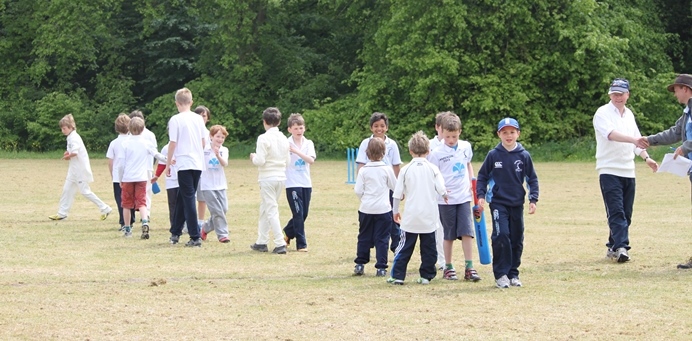
And what about the other 6 players on the batting team?
Good counting. Are you available to keep score for the Under-10s on Sunday?
They all sit patiently, watching their team-mates batting, applauding the good shots, calling encouragement after bad ones, waiting their turn. Or, as we coaches call it “messing about somewhere nearby – if you’re lucky”.
Who on earth keeps control of all this?
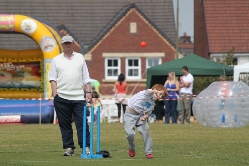 That’s the job of the umpire/coach/scorer, also sometimes known as “Daddy”. This mystical, all-powerful and all-seeing being stands like a colossus by the bowler’s wicket and maintains a zen-like calm and control as the mayhem and confusion prevails around him. At the same time, he performs a complex series of dance moves, including sticking one arm out; sticking two arms out; sticking one finger up; sticking both arms up; waving one arm from side to side … whilst intoning a timeless mantra: “play”, “over”, “not out”, “wide”, “no-ball”, “Johnny, take your hands out of your pockets”, “no, we don’t play LBW in Kwik Cricket”. As if all that weren’t heroic enough, this awesome being often wields a “clipboard” to which a piece of paper is fastened, on which he periodically inscribes a mysterious rune. The runes combine to comprise the “score”, the ultimate determinant of the success or failure of the efforts of the players.
That’s the job of the umpire/coach/scorer, also sometimes known as “Daddy”. This mystical, all-powerful and all-seeing being stands like a colossus by the bowler’s wicket and maintains a zen-like calm and control as the mayhem and confusion prevails around him. At the same time, he performs a complex series of dance moves, including sticking one arm out; sticking two arms out; sticking one finger up; sticking both arms up; waving one arm from side to side … whilst intoning a timeless mantra: “play”, “over”, “not out”, “wide”, “no-ball”, “Johnny, take your hands out of your pockets”, “no, we don’t play LBW in Kwik Cricket”. As if all that weren’t heroic enough, this awesome being often wields a “clipboard” to which a piece of paper is fastened, on which he periodically inscribes a mysterious rune. The runes combine to comprise the “score”, the ultimate determinant of the success or failure of the efforts of the players.
As if that weren’t enough … at the end of the game, this super-hero collects up the cricket kit; two forgotten water bottles; several hoodies; a half-eaten sandwich; three tea cups; and returns them to their rightful owners. Then he drives half the team home, whilst simultaneously fielding questions such as “I scored them most runs, didn’t I?”, “How many wickets did I take”, “Why didn’t you give Johnny out LBW?”, “Can I bat first next week?”, “Why did you say I was out when I wasn’t?” and – returning from the more far-flung matches – “Are we nearly home yet?”.
Where can I find more?
Here is the classic explanation of cricket: http://www.intermain.org.uk/john/what_is_cricket.php

